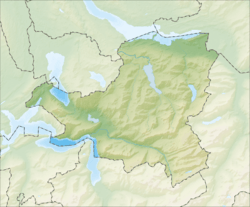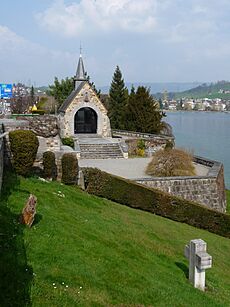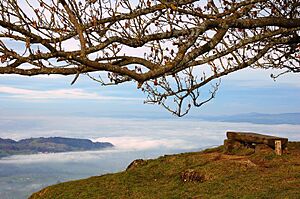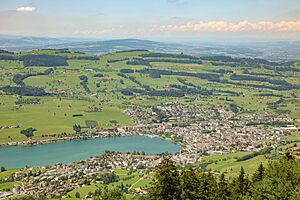Küssnacht facts for kids
Quick facts for kids
Küssnacht
|
||
|---|---|---|
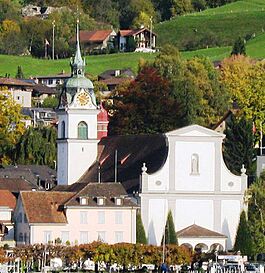 |
||
|
||
| Country | Switzerland | |
| Canton | Schwyz | |
| District | Küssnacht | |
| Area | ||
| • Total | 29.37 km2 (11.34 sq mi) | |
| Elevation
(Hauptplatz, Küssnacht)
|
441 m (1,447 ft) | |
| Population
(Dec 2020 )
|
||
| • Total | 13,531 | |
| • Density | 460.71/km2 (1,193.23/sq mi) | |
| Postal code |
6403
|
|
| Localities | Küssnacht SZ, Immensee, Merlischachen | |
| Surrounded by | Greppen, Meggen, Adligenswil, Udligenswil, Meierskappel, Risch, Walchwil and Arth | |
| Twin towns | Küssaberg (Germany), Zduny (Poland) | |
Küssnacht, officially known as Küssnacht am Rigi, is a charming village in Switzerland. It is located in the canton of Schwyz. Küssnacht is both a village and a larger area called a district and municipality.
The municipality of Küssnacht includes three main villages: Küssnacht, Immensee, and Merlischachen. It also has a smaller area called Haltikon and an industrial zone known as Fänn. You can also find the beautiful alpine pasture called Seeboden here. Küssnacht is nestled between two lakes, Lake Lucerne to the north and Lake Zug to the south. It sits right below the impressive Rigi mountain, which is about 1,797 meters (5,896 feet) tall.
Contents
History of Küssnacht
Küssnacht was first mentioned in old writings around the year 840. However, the oldest copy of this document is from the 11th century. Later, in 1179, it was mentioned again as Chussenacho.
In 1424, Küssnacht became an important "district" within the Canton of Schwyz. The name "Küssnacht" comes from German words that mean "Kiss" and "Night."
The Legend of William Tell
Küssnacht is famous for its connection to the legend of William Tell. Tell was a legendary hero who fought for Swiss freedom. According to the story, he shot the evil Austrian bailiff (a type of governor) named Gessler with his crossbow. This happened in a narrow path called the Hohle Gasse, close to the Gesslerburg castle.
The famous writer Friedrich Schiller wrote about this moment in his play William Tell: "Here through this deep defile he needs must pass; there leads no other road to Küssnacht."
Queen Astrid's Memorial
On August 29, 1935, something sad happened in Küssnacht. Queen Astrid of Belgium passed away in a car accident here. A special chapel, called the "Königin-Astrid-Kapelle" (Queen Astrid Chapel), was built at the accident site to remember her. In 1989, the chapel was damaged but was quickly rebuilt later that same year.
Klausjagen Festival
Every year, on the evening before St. Nicholas Day (December 5), Küssnacht hosts a unique festival called Klausjagen. This "Nicholas chase" is very popular, with about 20,000 people attending. Around 1,000 participants join a lively parade that continues late into the night.
Geography of Küssnacht
Küssnacht covers an area of about 36.20 square kilometers (13.98 square miles). A large part of this land, about 55.8%, is used for farming. Forests cover another 26.4% of the area. About 16.5% of the land is developed with buildings and roads.
The municipality is located at the base of the Rigi mountain. It is nestled between the Lake of Lucerne and Lake Zug. As mentioned before, it includes the villages of Küssnacht, Immensee, and Merlischachen. It also has smaller areas like Haltikon and Seebodenalp. Küssnacht is the main town and the only municipality in its district.
People and Population
Küssnacht has a population of about 12,423 people (as of 2015). About 21.1% of the people living here are foreign nationals. A small group, about 5.2% of the population, were born in Germany. The population has grown by about 1.63% between 2010 and 2015.
Most people in Küssnacht (about 87.5%) speak German. Other languages spoken include Albanian and Serbo-Croatian, each by about 2.7% of the population.
In 2015, children and teenagers (ages 0–19) made up 19.6% of the population. Adults (ages 20–64) were 62.4%, and seniors (over 64) were 18.0%.
The historical population of Küssnacht has changed over time, as shown in the chart below:

Important Heritage Sites
Küssnacht has some very important historical places. These are called heritage sites of national significance. They include the ruins of Gesslerburg Castle and the Hohle Gasse with the Tell Chapel. The village of Küssnacht am Rigi and the small area of Merlischachen are also recognized as important heritage sites.
Education in Küssnacht
Many adults in Küssnacht have a good education. About 72.9% of people aged 25–64 have completed either a non-mandatory upper secondary education or a higher education degree, like from a university.
Getting Around (Transportation)
Küssnacht has good transportation options. There are three railway stations: Küssnacht am Rigi, Immensee, and Merlischachen. All of these stations are on the Lucerne–Immensee railway line.
You can also travel by boat! The ferry terminal at Küssnacht am Rigi (See) is close to the railway station. From here, you can take a ferry to many different places on Lake Lucerne.
Economy and Jobs
Küssnacht is an important business center for its region. In 2014, there were over 6,800 people working in the municipality.
Jobs are divided into three main groups:
- Primary sector: This includes jobs like farming.
- Secondary sector: This involves manufacturing and construction.
- Tertiary sector: This covers services, like shops, hotels, and offices.
In 2015, hotels in Küssnacht had over 61,000 overnight stays. More than half of these visitors (55.6%) were from other countries, showing that Küssnacht is a popular place for tourists.
Religion
According to a census from 2000, most people in Küssnacht are Roman Catholic (about 73.7%). About 10.8% belong to the Swiss Reformed Church. There are also people who belong to the Eastern Orthodox Church and Islamic faiths. Some people belong to other churches, or do not belong to any church at all.
Notable People from Küssnacht
- Hekuran Kryeziu (born 1993), a professional football (soccer) player.
- César Ritz, a famous hotelier (someone who owns or manages hotels).
See also
 In Spanish: Küssnacht am Rigi para niños
In Spanish: Küssnacht am Rigi para niños




